Stalagmites and Rodent Bones Record Signs of Ice Age Texas
May 12, 2017
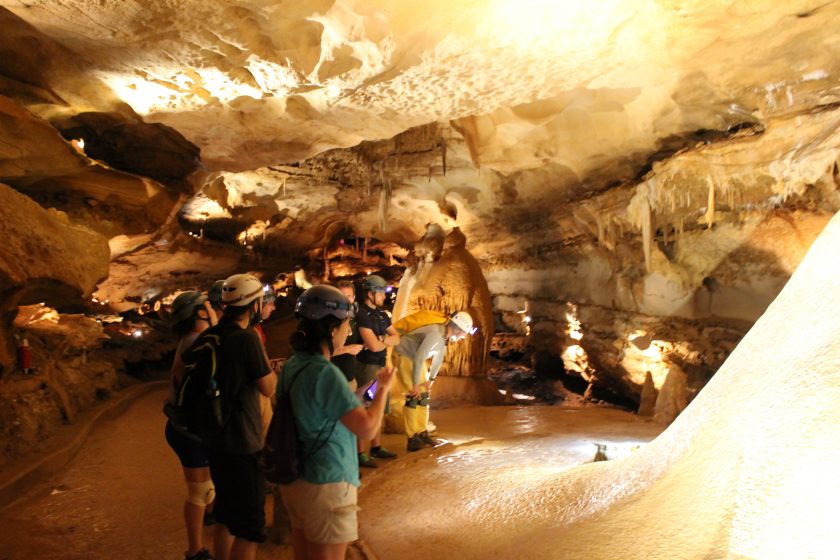
By Monica Kortsha
Inner Space Cavern is a fossil hot spot. Thanks to sinkholes that exposed the cave to the surface during the last Ice Age, the cave has amassed a collection of mammoths, saber-toothed cats, glyptodons, and other museum collection favorites. But while crawling on my hands and knees over slick red mud through a narrow passage not much wider than I am, I felt connected to a more familiar mammal that once called the Texas Hill Country home: the humble prairie dog.
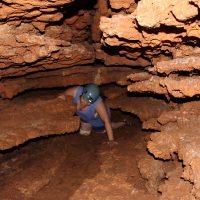
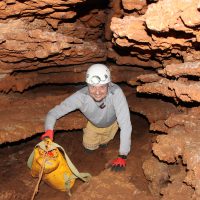
Prairie dogs require deep soil to make their complex tunneling burrows that can reach 10 feet below the surface, so the presence of prairie dog fossils at Inner Space indicate that the Hill Country had a very different ecology thousands of years ago. It’s a conclusion that’s bolstered by the very geology of the cave itself: some stalagmites and stalactites are streaked with brown layers—a sign that soil seeped in with the groundwater and minerals that built the structures over time.
Jackson School Professor and Director of UT’s Environmental Science Institute (ESI), Jay Banner, pointed out the connection between these “chocolate and vanilla speleothems” and Ice Age prairie dogs on a recent trip inside the cavern. By asking questions about the origins of the colors, and how they overlapped, Banner helped the caving group understand how these streaked cave structures served as instant indicators that the Hill Country soil wasn’t always so thin.
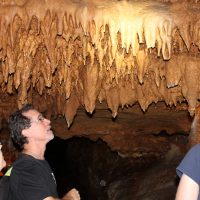
On our trip, Banner was a guide to cave geology and chemistry. He explained how to interpret the cave to understand the processes that have been building its environment over the past 100 million years.
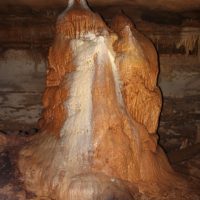
Our group was made up of eight people, each connected to the ESI program in some way. Deena Telley, a teacher at Austin High and a participant in ESI’s SciRes program was interested in scoping out the cave to see if it could be integrated into a lesson plan; Jason Julian, an associate professor at Texas State University and a member of ESI’s Texas Water Research Network wanted to learn more about how the cave impacts water resources in Texas—a question that he’s frequently asked by students; and Jackson School Assistant Professor Nicola Tisato came to deploy a sensor to measure temperature and depth in the cave. It’s a test run for the device, which he plans to use to study a cave in Italy where water depth is more variable.
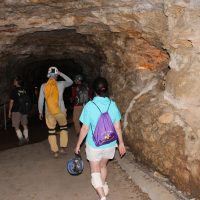
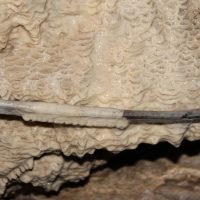
Located about 30 minutes away from the main UT Austin campus in Georgetown, Inner Space is a roadside attraction, with the visitor center situated right along I-35. The accessibility has its perks. It has allowed Banner to conduct research in the cave for the past 20 years. And the wide, human-dug entrance that allows tour groups to easily descend into the main chambers creates a perfect environment for illustrating how quickly speleothems—the word for cave rock formations like stalagmites and stalactites—can grow given the right conditions. The ample carbon dioxide from the atmosphere—perhaps enhanced by emissions from the nearby highway—mixing freely with the moist air at the cave entrance has built new rock along the electrical wiring leading into the cave in only a few decades time.
We began our caving trip on the main tour path taken by all visitors to the caves, with Banner quizzing the group on how the flow of water influenced the growth of various formations. Mineral deposits brought by trickling water are responsible for building the cave’s speleothems. But the cave itself is the result of water dissolving away fractures and pores in the rock. Banner defines a cave simply as a pore large enough for humans to enter.
Before descending into a cave, we used a compass and a map of Texas to find the direction of the Balcones fault zone, a collection of faults and fractures that curves across the state from Del Rio up to Dallas. When we entered the curved chamber of the Discovery Room we took our compasses out again and got the same coordinates we calculated from the map—19 degrees east from north. It’s a sign that cave formation has been guided by the Balcones.
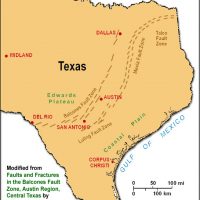
Right before we went off the main trail to take a look at Banner’s experiments, we passed by a mural of ancient animals that have been found in the cave—including the prairie dog. Then we all squeezed our way through the tight passageway.
Banner’s experiments involve tracking speleothem growth by measuring how much calcite minerals are deposited on a speleothem over time. The setup is simple: glass plates placed on top of stalagmites catch the drops, and the amount of calcite deposited is determined by weighing the plate every few weeks. The research has found that calcite precipitation from the drop is influenced by changes in the air temperature at the surface, which in turn influences the carbon dioxide concentration in the cave. It’s a finding that means speleothems can potentially record the climate from the outside world on a seasonal scale all while being located a hundred feet below the surface. By continuing to track calcite growth, Banner is measuring how climate impacts the cave environment—and how well the cave environment records climate.
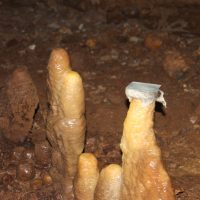
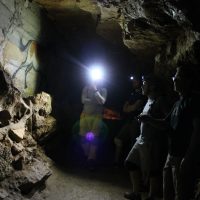
At one of the research sites we all gathered together and turned off our headlamps, the only source of illumination in the cave, and sat silently. The world went black and I closed my eyes to make the nothingness easier to process. But the cave didn’t go silent. Drips of water continued to fall from the stalactites, and every few minutes we all heard a distant rumbling: the sound of semi-trucks speeding overhead down I-35. The sounds were a reminder that even deep underground there are signals from the surface. Recorded by speleothems and skeletons, caves keep track of the ephemeral processes that are constantly passing us by.
To visit Inner Space Cavern from home, check out this virtual tour of the cave guided by Banner.
